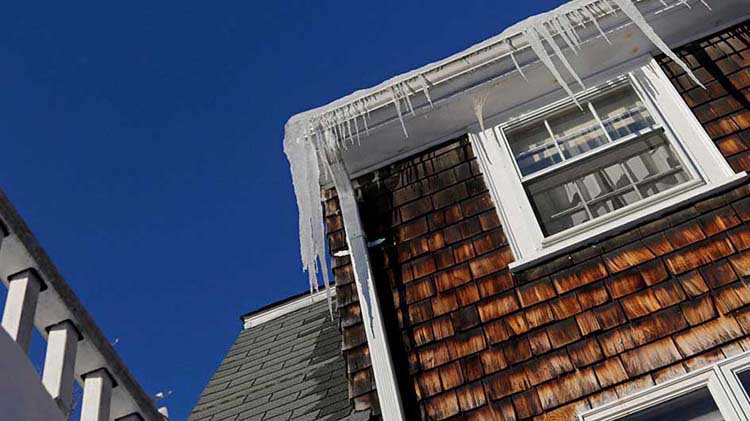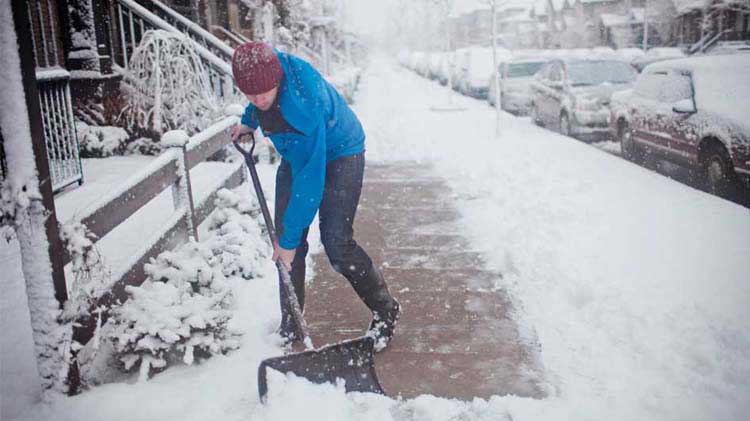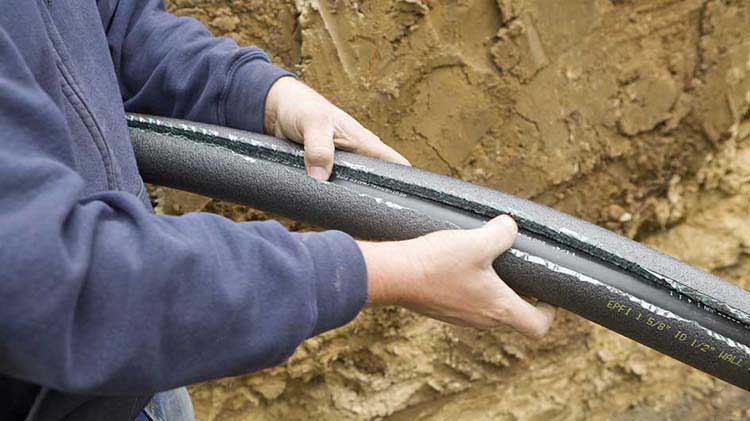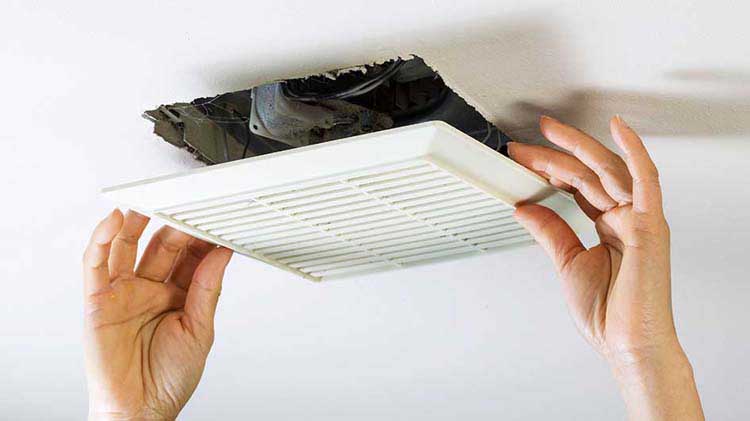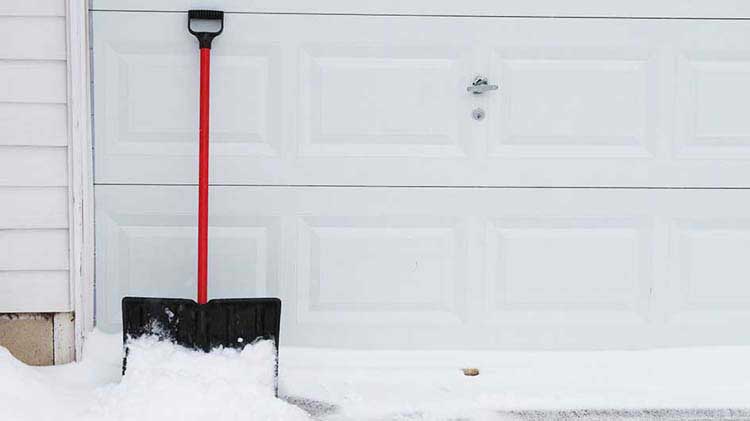Winter water damage from ice dams, attic condensation & more
Excessive snow on the roof, condensation in the attic and ice buildup can cause roof & water damage and personal injury.
While stopping a water leak or repairing a washing machine hose down in the basement might be fairly straightforward, snow on the roof, ice dams and attic condensation are forms of water damage typical to cold climate homes and are a little more complicated and a little trickier to fix.
Why is excessive snow on your roof a concern? What are ice dams? What causes attic condensation? And if you've had these, what can you do?
Why should you worry about snow on the roof?
Heavy loads of ice and snow on your roof can create serious problems. These include:
- Injuries from snow and ice falling from sloped roofs.
- Roof collapse, especially on flat roofs.
- Carbon monoxide poisoning resulting from blocked chimneys and vents.
- Water damage from ice dams that form on the edges of roofs and in gutters.
What are ice dams?
When the temperature in your attic is above freezing, snow on the roof will likely melt. When the snowmelt runs down the roof and hits the colder eaves, it refreezes.
If this cycle repeats over several days, the freezing snowmelt builds up and forms an ice dam, behind which water pools into large puddles, or "ponds". The ponding water can then back up under the roof covering and leak into the attic or along exterior walls.
The right weather conditions for ice dams are usually when outside air temperatures are in the low 20s (°F) for several days with several inches of snow on the roof.
What causes condensation in your attic?
Condensation of water vapor on cold surfaces in attics can cause wood to rot, which can lead to costly repairs.
Attic condensation typically occurs when warm, moist air migrates or is directed into the attic from living spaces below. Research indicates unusually high humidity in the home's living spaces is strongly associated with attic condensation problems.
Winter water damage warning signs to watch for
Recognize the signs of stress when too much snow and ice has accumulated on your roof or when you have too much condensation in your attic. Here are a few things to watch for.
- Sagging ridgeline
- Drooping ceilings
- Water leaks on interior walls and ceilings
- Jammed doors
- Cracked interior walls near the center of your home
- Creaking sounds
Condensation, snow on roof and ice dam prevention tips
Building codes have some requirements that attempt to prevent the problems of ice dams and attic condensation. But codes don't address all the issues, and many houses could have out of date building codes.
- Bathroom and kitchen exhaust fans, as well as dryer vents, should never be discharged into the attic space and always discharge outside. You may have an adequately ventilated attic, but this won't matter if the bathroom exhaust fan dumps warm moist air directly into the attic space. This could result in condensed water vapor freezing onto cold attic materials, which will eventually thaw creating wet attic materials resulting in damage in the attic and inside the home.
- Minimize ceiling mounted fixtures below the attic that create the need for holes in the drywall or plaster ceiling. Properly seal ceiling penetrations to make them airtight taking care to follow manufacturer clearance requirements for flues, chimneys and recessed light fixtures.
- Research shows keeping the attic air temperature below freezing when the outside air temperature is in the low 20s can reduce the occurrence of ice dams. Proper attic ventilation is key to keeping the attic cool, while adequate and properly installed insulation is key to keeping your house warm. It is critical to keep soffit vents free from obstructions to allow the natural flow of cool outside air into the attic space to replace the warmer attic air that rises and flows outside the ridge and/or roof vents. This flow of air will keep the attic cool and free of moisture build-up.
Removing ice and snow from your roof is a dangerous job. Avoid injury by hiring a professional to remove snow and ice from the roof and fix the problem before it leads to property damage and expensive repairs. Here are some tips to keep in mind.
- Add insulation to your attic to help prevent your home's warm air from escaping into unheated attic spaces.
- If replacing your home's roof, have a self-sealing membrane installed under the shingles to help prevent water damage from ice dams.
- On metal roofs, install snow guards above entrances.
What not to do
While it might be tempting to try a quick fix to break up that ice dam, don't get too eager; not only is it dangerous on your roof, but you can also cause a lot of damage, especially in the colder months. Here are some things to consider.
- Do not routinely remove snow from the roof or attempt to "chip away"the ice of an ice dam. It will likely lead to shingle damage.
- Do not install large mechanical equipment or water heaters in attics, especially in cold climates. Not only do they present an unwelcome fire hazard, but they'll also increase the temperature in your attic.
- Do not routinely use salt or calcium chloride to melt snow on a roof. These chemicals are very corrosive and can shorten the life of metal gutters, downspouts and flashings. Runoff that contains high concentrations of these chemicals can damage nearby grass and plants.
What to do
- Follow up with your new home or home-improvement contractor to be sure that insulation in the attic space is adequate for your location.
- Verify soffit and roof or ridge venting exists for all roof planes and that soffit vents are neither blocked by attic insulation nor covered by newly installed maintenance free finishes outside the home.
- Verify all penetrations, access panels and electrical fixtures are properly sealed and insulated to prevent heat and moisture from entering the attic space, while maintaining manufacturer's required clearances.
- Verify all exhaust fans and dryer vents are discharged to the outside.
- Keep gutters clean of leaves and other debris. This will not necessarily prevent ice dams, but clean gutters can help drain away ice melt as it makes its way to the gutters during a thaw.
- Follow up a short-term ice dam remedy with determining and fixing the actual cause to your ice dam problem. Consult a trusted and competent professional.
If your home suffers damage this winter, contact your State Farm® agent to see if it's covered under your homeowner's policy. Check out more winter home maintenance tips here.
